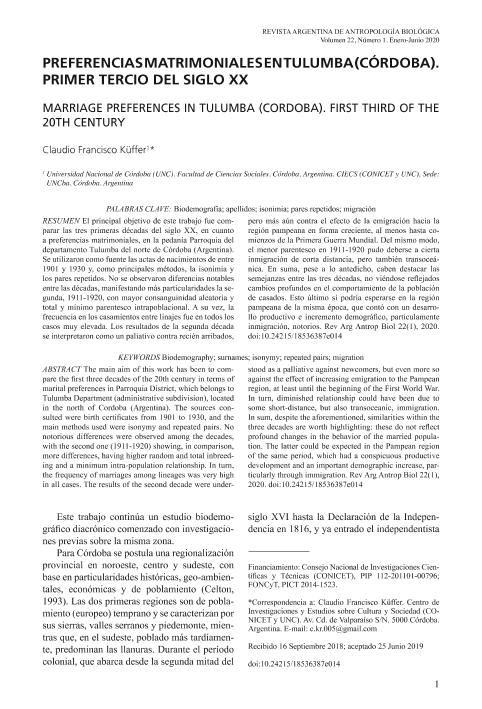Artículo
El principal objetivo de este trabajo fue comparar las tres primeras décadas del siglo XX, en cuanto a preferencias matrimoniales, en la pedanía Parroquia del departamento Tulumba del norte de Córdoba (Argentina). Se utilizaron como fuente las actas de nacimientos de entre 1901 y 1930 y, como principales métodos, la isonimia y los pares repetidos. No se observaron diferencias notables entre las décadas, manifestando más particularidades la segunda, 1911-1920, con mayor consanguinidad aleatoria y total y mínimo parentesco intrapoblacional. A su vez, la frecuencia en los casamientos entre linajes fue en todos los casos muy elevada. Los resultados de la segunda década se interpretaron como un paliativo contra recién arribados, pero más aún contra el efecto de la emigración hacia la región pampeana en forma creciente, al menos hasta comienzos de la Primera Guerra Mundial. Del mismo modo, el menor parentesco en 1911-1920 pudo deberse a cierta inmigración de corta distancia, pero también transoceánica. En suma, pese a lo antedicho, caben destacar las semejanzas entre las tres décadas, no viéndose reflejados cambios profundos en el comportamiento de la población de casados. Esto último sí podría esperarse en la región pampeana de la misma época, que contó con un desarrollo productivo e incremento demográfico, particulamente inmigración, notorios. The main aim of this work has been to compare the first three decades of the 20th century in terms of marital preferences in Parroquia District, which belongs to Tulumba Department (administrative subdivision), located in the north of Cordoba (Argentina). The sources consulted were birth certificates from 1901 to 1930, and the main methods used were isonymy and repeated pairs. No notorious differences were observed among the decades, with the second one (1911-1920) showing, in comparison, more differences, having higher random and total inbreeding and a minimum intra-population relationship. In turn, the frequency of marriages among lineages was very high in all cases. The results of the second decade were understood as a palliative against newcomers, but even more so against the effect of increasing emigration to the Pampean region, at least until the beginning of the First World War. In turn, diminished relationship could have been due to some short-distance, but also transoceanic, immigration. In sum, despite the aforementioned, similarities within the three decades are worth highlighting: these do not reflect profound changes in the behavior of the married population. The latter could be expected in the Pampean region of the same period, which had a conspicuous productive development and an important demographic increase, particularly through immigration.
Preferencias matrimoniales en Tulumba (Córdoba): Primer tercio del siglo XX
Título:
Marriage preferences in Tulumba (Cordoba): First third of the 20th century
Fecha de publicación:
12/2020
Editorial:
Asociación Antropología Biológica Argentina
Revista:
Revista Argentina de Antropología Biológica
ISSN:
1514-7991
e-ISSN:
1853-6387
Idioma:
Español
Tipo de recurso:
Artículo publicado
Clasificación temática:
Resumen
Palabras clave:
BIODEMOGRAFÍA
,
APELLIDOS
,
ISONIMIA
,
PARES REPETIDOS
,
MIGRACIÓN
Archivos asociados
Licencia
Identificadores
Colecciones
Articulos(CIECS)
Articulos de CENTRO DE INVESTIGACIONES Y ESTUDIO SOBRE CULTURA Y SOCIEDAD
Articulos de CENTRO DE INVESTIGACIONES Y ESTUDIO SOBRE CULTURA Y SOCIEDAD
Citación
Küffer, Claudio Francisco; Preferencias matrimoniales en Tulumba (Córdoba): Primer tercio del siglo XX; Asociación Antropología Biológica Argentina; Revista Argentina de Antropología Biológica; 22; 1; 12-2020; 1-12
Compartir
Altmétricas




